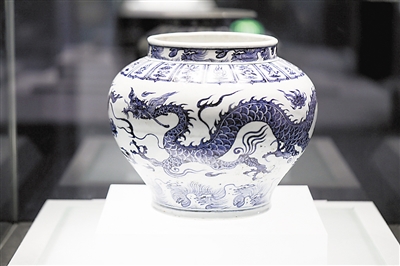
 |
| A blue and white 'dragon' jar on display at the National Museum of China. (PHOTO: VCG) |
Blue and white porcelain is thought to have originated in the Tang Dynasty (618-907), however it didn't really flourish until the Ming and Qing Dynasties, reaching an unparalleled golden age in Chinese ceramic history.
The emergence of blue and white porcelain shattered the confines of Chinese monochrome-glazed ceramics, ushering in a new era of underglaze painting and giving rise to the distinctive style associated with Jingdezhen porcelain.
Blue and white porcelain is crafted using cobalt ore that contains cobalt oxide as its raw material. The process involves coloring and depicting intricate patterns on the porcelain matrix, followed by the application of a layer of transparent glaze. Finally, it is fired at a high temperature of more than 1000℃.
Its composition is rich and multi-layered, yet harmoniously balanced. The brushwork is characterized by confident, smooth and powerful strokes, while the outline rendering exudes a strong and calm presence. Motifs taken from nature, such as lotus blossoms, peonies and landscape scenes, often feature on the pieces, reflecting the traditional Chinese aesthetics.
Blue and white porcelain boasts a diverse array of shapes, ranging from small bird feeders to large jars. In the past, as production increased and costs fell, blue and white decoration products not only met the daily needs of the palace, but were also extensively exported as commodities, and given as gifts to foreign tribute-payers, becoming a witness to cultural exchanges between the East and the West.







